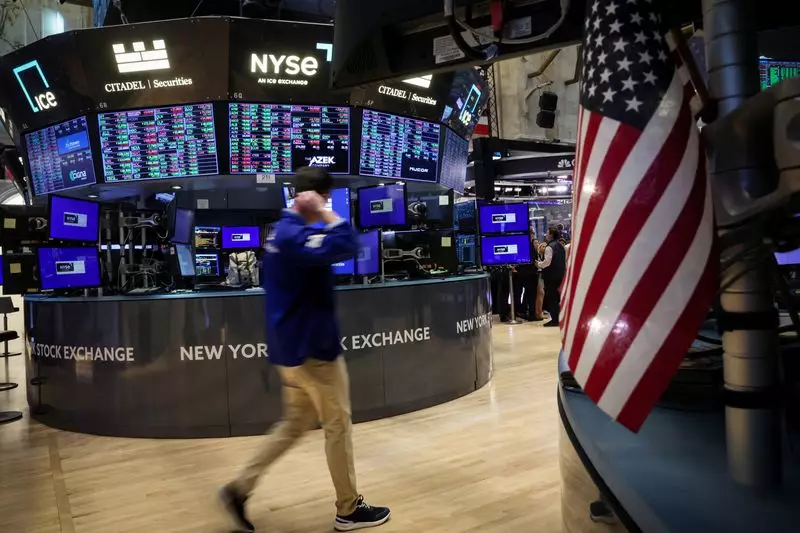In a remarkable display of resilience and optimism, the major U.S. stock indices—the Dow Jones Industrial Average, the S&P 500, and the Nasdaq Composite—climbed to record closing highs on Friday. This significant uptick in market performance was largely fueled by robust earnings, particularly from Netflix, which spurred enthusiasm across technology sectors. This week marks an impressive achievement for investors, who have witnessed a consistent upward trend as all three indices marked their sixth consecutive weekly gains. Such a sustained rally is a rare occurrence in the financial landscape and indicates a strong bullish sentiment prevailing among market participants.
Specific numbers are telling: the S&P 500 concluded the week up by 0.9%, while the Nasdaq and Dow rose by 0.8% and 1%, respectively. The standout performer, Netflix, saw its shares surge an astonishing 11.1% following its announcement of better-than-expected subscriber growth, setting a new record for the company. The ripple effect from this news was felt widely, with many tech giants, referred to as the “Magnificent Seven,” including Apple and Nvidia, also benefiting from the positive sentiment in the sector.
Technology’s strong showing was not a standalone phenomena but rather indicative of broader market dynamics. The communication services sector, buoyed by Netflix’s success, increased by 0.9%, making it the top performer among the eleven S&P 500 sectors. Conversely, the energy sector faced headwinds, primarily due to falling oil prices that fell by 7% amid concerns regarding demand from China and geopolitical tensions in the Middle East. These mixed signals hint at a complex market environment, which investors must navigate carefully.
Despite positive economic indicators and earnings reports, concerns linger regarding the sustainability of these gains. The S&P 500 is trading at approximately 22 times its forward earnings, suggesting that valuations have reached elevated levels. This raises an important question: will corporate earnings continue to justify these high valuations, or are we positioned for a potential market pullback? David Waddell, CEO of Waddell & Associates, expressed a critical perspective, noting that while strong corporate earnings could mitigate fears of overvaluation, any major disappointments could lead to significant market corrections.
The current market environment seems to favor large-cap stocks, as investors are gravitating towards established players with proven track records. Interestingly, small-cap stocks—often viewed as riskier but potentially rewarding investments—are also gaining traction, outperforming their larger counterparts for much of the week. This willingness to invest in smaller companies suggests mounting confidence in a broader economic recovery and may signal a shift in investor strategies as they seek out growth opportunities beyond the tech giants.
It’s crucial to consider the potential implications of the approaching U.S. presidential election scheduled for November 5. Political uncertainties often create volatility, and with high expectations set for corporate earnings, any political developments could significantly influence investor behavior. Analysts argue that the path to profit remains heavily reliant on company performance, and could spell trouble for stocks if expectations aren’t met.
The energy sector’s recent struggles underscore the complexities of the current market environment. As oil prices consistently drop, companies within the sector like SLB and Baker Hughes recorded losses following disappointing earnings reports. These trends reflect broader economic issues, particularly as fluctuating global demand recalibrates the energy landscape. As U.S. crude prices continue to decline, investors should closely monitor these developments to gauge the potential fallout from reduced energy sector performance.
In addition to the energy challenges, other sectors like healthcare have started to show cracks as well. CVS Health’s replacement of its CEO and subsequent withdrawal of profit forecasts served as a wake-up call to investors, affecting overall market sentiment. Such organizational instability within major firms can have far-reaching effects, and shareholders must remain vigilant as they evaluate the health of their investments.
As we move forward in this multifaceted economic climate, investors find themselves at a crossroads of optimism and caution. While record highs in major indices provide a compelling narrative of growth, underlying factors such as stretched valuations and sector-specific challenges urge a more nuanced approach to investment strategy. Navigating the post-COVID economic recovery involves not just capitalizing on growth opportunities, but also safeguarding against potential downturns triggered by earnings discrepancies, geopolitical conflicts, or electoral unpredictability.
The recent performance of the markets showcases a complex interplay between bullish sentiment and underlying economic realities. Investors are advised to remain informed and flexible, acknowledging that while the current trajectory appears favorable, the market’s capacity for volatility means the landscape could shift dramatically in the near future.

